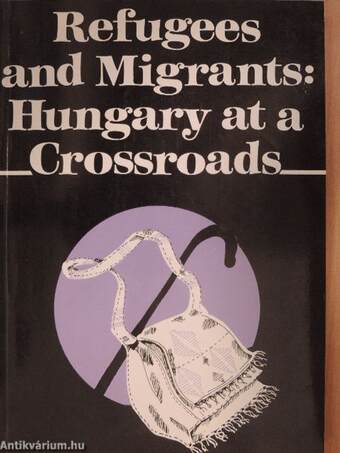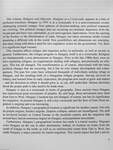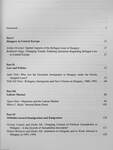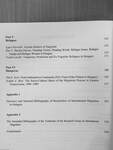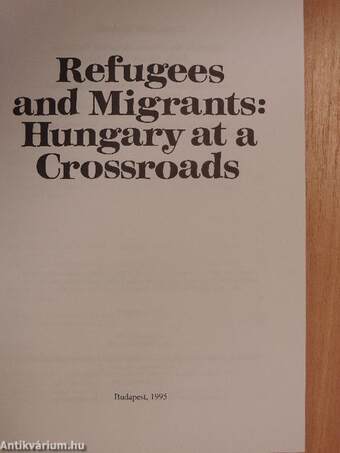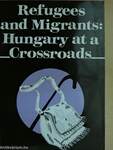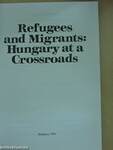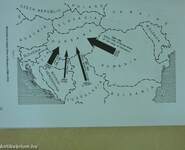1.066.213
kiadvánnyal nyújtjuk Magyarország legnagyobb antikvár könyv-kínálatát

VISSZA
A TETEJÉRE
JAVASLATOKÉszre-
vételek
Refugees and Migrants
Hungary at a Crossroads
| Kiadó: | Institute for Political Sciences of the Hungarian Academy of Sciences |
|---|---|
| Kiadás helye: | Budapest |
| Kiadás éve: | |
| Kötés típusa: | Ragasztott papírkötés |
| Oldalszám: | 256 oldal |
| Sorozatcím: | |
| Kötetszám: | |
| Nyelv: | Angol |
| Méret: | 23 cm x 16 cm |
| ISBN: | |
| Megjegyzés: | További szerzők a kötetben. Fekete-fehér ábrákkal. |
naponta értesítjük a beérkező friss
kiadványokról
naponta értesítjük a beérkező friss
kiadványokról
Fülszöveg
This volume, Refugees and Migrants: Hungary at a Crossroads, appears at a time of
profound transition. Hungary in 1995 is at a crossroads: it is a post-communist society
undergoing systemic change. New patterns of decision-making, new political responses
are evolving. The political changes that are occurring are dramatic departures from the
recent past and have very substantial, as yet unrecognized, implications. From the opening
of the borders to the liberalization of trade, Hungary has taken enormous strides toward
assuming a different role in the world. New possibilities and dimensions are emerging,
and many bring with them a need for new regulatory action by the government. Yet, there
is a significant legal vacuum.
This situation affects refugee and migration policy in particular, as well as society in
general. Furthermore, the refugee program in Hungary itself is at a crossroads. Refugees
are fundamentally a new phenomenon in Hungary. Prior to the late 1980s there... Tovább
Fülszöveg
This volume, Refugees and Migrants: Hungary at a Crossroads, appears at a time of
profound transition. Hungary in 1995 is at a crossroads: it is a post-communist society
undergoing systemic change. New patterns of decision-making, new political responses
are evolving. The political changes that are occurring are dramatic departures from the
recent past and have very substantial, as yet unrecognized, implications. From the opening
of the borders to the liberalization of trade, Hungary has taken enormous strides toward
assuming a different role in the world. New possibilities and dimensions are emerging,
and many bring with them a need for new regulatory action by the government. Yet, there
is a significant legal vacuum.
This situation affects refugee and migration policy in particular, as well as society in
general. Furthermore, the refugee program in Hungary itself is at a crossroads. Refugees
are fundamentally a new phenomenon in Hungary. Prior to the late 1980s there were no
laws regulating refugees, no organizations dealing with refugees, and practically no refu-
gees. This has all changed. The transformation is, of course, interrelated with the basic
political changes that are occurring, but it has its own unique development and conse-
quences. The past few years have witnessed thousands of individuals seeking refuge in
Hungary, and the resulting birth of a Hungarian refugee program. Having survived its
infancy and learned from its early experience, the program now needs to grow and mature
- and the direction in which it should grow is, as yet, still undecided. Serious decisions
about the proper path to take need to be made soon.
Hungary is also at a crossroads in terms of geography. Since ancient times Hungary
has experienced great movements of peoples. By and large, these movements have been
from East to West. Hungary's location has not changed, of course, nor has its significance
for migration. At present Hungary is still a key crossroads and the flow of East-West mi-
gration is ongoing and even increasing.
In addition, Hungary's geographical location is significant for another reason. Not only
do people migrate; borders migrate. Empires collapse; nations are reconfigured. The shift
in territorial borders in Central Europe in the twentieth century and the migration that
ensued have had an enormous impact on Hungary and population movements.
Furthermore, Hungary's geographical location has made it a transit country. Migrants
cross Hungary on the way to other destinations. Indeed, its location on routes from the
south of Europe to the north, as well as on well-traveled routes from East to West, has
made Hungary a major junction for transit migration. This transit aspect has had a perva- Vissza
Témakörök
- Történelem > Társadalomelmélet
- Szociológia > Társadalmi csoportok > Kisebbségek > Bevándorlók
- Idegennyelv > Idegennyelvű könyvek > Angol > Szociológia > Társadalmi csoportok > Kisebbségek > Bevándorlók
- Idegennyelv > Idegennyelvű könyvek > Angol > Történelem > Európa története > Magyarország története
- Szociológia > Szociálpolitika > Egyéb
- Szociológia > Magyarországon
- Szociológia > Tanulmányok, esszék
- Idegennyelv > Idegennyelvű könyvek > Angol > Szociológia > Magyarországon
- Idegennyelv > Idegennyelvű könyvek > Angol > Szociológia > Tanulmányok, esszék
- Idegennyelv > Idegennyelvű könyvek > Angol > Szociológia > Szociálpolitika > Egyéb
- Történelem > Idegennyelvű > Angol
- Történelem > Politika > Belpolitika > Kisebbségi kérdés
- Történelem > Magyarország története és személyiségei > Átfogó művek, tanulmányok
- Történelem > Magyarország története és személyiségei > Magyarország a XX. században > A II. világháború utáni Magyarország > A rendszerváltás utáni Magyarország > Belpolitika



